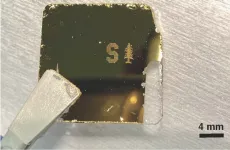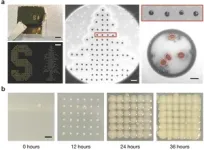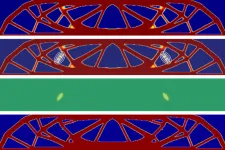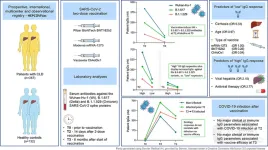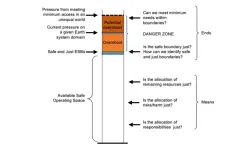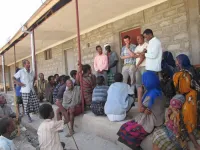(Press-News.org) Shine a laser on a drop of blood, mucus, or wastewater, and the light reflecting back can be used to positively identify bacteria in the sample.
“We can find out not just that bacteria are present, but specifically which bacteria are in the sample – E. coli, Staphylococcus, Streptococcus, Salmonella, anthrax, and more,” said Jennifer Dionne, an associate professor of materials science and engineering and, by courtesy, of radiology at Stanford University. “Every microbe has its own unique optical fingerprint. It’s like the genetic and proteomic code scribbled in light.”
Dionne is senior author of a new study in the journal Nano Letters detailing an innovative method her team has developed that could lead to faster (almost immediate), inexpensive, and more accurate microbial assays of virtually any fluid one might want to test for microbes.
Traditional culturing methods still in use today can take hours if not days to complete. A tuberculosis culture takes 40 days, Dionne said. The new test can be done in minutes and holds the promise of better and faster diagnoses of infection, improved use of antibiotics, safer foods, enhanced environmental monitoring, and faster drug development, says the team.
Old dogs, new tricks
The breakthrough is not that bacteria display these spectral fingerprints, a fact that has been known for decades, but in how the team has been able to reveal those spectra amid the blinding array of light reflecting from each sample.
“Not only does each type of bacterium demonstrate unique patterns of light but virtually every other molecule or cell in a given sample does too,” said first author Fareeha Safir, a PhD student in Dionne’s lab. “Red blood cells, white blood cells, and other components in the sample are sending back their own signals, making it hard if not impossible to distinguish the microbial patterns from the noise of other cells.”
A milliliter of blood – about the size of a raindrop – can contain billions of cells, only a few of which might be microbes. The team had to find a way to separate and amplify the light reflecting from the bacteria alone. To do that, they ventured along several surprising scientific tangents, combining a four-decade-old technology borrowed from computing – the inkjet printer – and two cutting-edge technologies of our time – nanoparticles and artificial intelligence.
“The key to separating bacterial spectra from other signals is to isolate the cells in extremely small samples. We use the principles of inkjet printing to print thousands of tiny dots of blood instead of interrogating a single large sample,” explained co-author Butrus “Pierre” Khuri-Yakub, a professor emeritus of electrical engineering at Stanford who helped develop the original inkjet printer in the 1980s.
“But you can’t just get an off-the-shelf inkjet printer and add blood or wastewater,” Safir emphasized. To circumvent challenges in handling biological samples, the researchers modified the printer to put samples to paper using acoustic pulses. Each dot of printed blood is then just two trillionths of a liter in volume – more than a billion times smaller than a raindrop. At that scale, the droplets are so small they may hold just a few dozen cells.
In addition, the researchers infused the samples with gold nanorods that attach themselves to bacteria, if present, and act like antennas, drawing the laser light toward the bacteria and amplifying the signal some 1500 times its unenhanced strength. Appropriately isolated and amplified, the bacterial spectra stick out like scientific sore thumbs.
The final piece of the puzzle is the use of machine learning to compare the several spectra reflecting from each printed dot of fluid to spot the telltale signatures of any bacteria in the sample.
“It’s an innovative solution with the potential for life-saving impact. We are now excited for commercialization opportunities that can help redefine the standard of bacterial detection and single-cell characterization,” said senior co-author Amr Saleh, a former postdoctoral scholar in Dionne’s lab and now a professor at Cairo University.
Catalyst for collaboration
This sort of cross-disciplinary collaboration is a hallmark of the Stanford tradition in which experts from seemingly disparate fields bring their varying expertise to bear to solve longstanding challenges with societal impact.
This particular approach was hatched during a lunchtime meeting at a café on campus and, in 2017, was among the first recipients of a series of $3 million grants distributed by Stanford’s Catalyst for Collaborative Solutions. Catalyst grants are specifically targeted at inspiring interdisciplinary risk-taking and collaboration among Stanford researchers in high-reward fields such as health care, the environment, autonomy, and security.
While this technique was created and perfected using samples of blood, Dionne is equally confident that it can be applied to other sorts of fluids and target cells beyond bacteria, like testing drinking water for purity or perhaps spotting viruses faster, more accurately, and at lower cost than present methods.
Additional Stanford co-authors include former PhD student Loza Tadesse; research staff Kamyar Firouzi; Niaz Banaei, professor of pathology and of medicine at the School of Medicine; and Stefanie Jeffrey, the John and Marva Warnock Professor, Emerita, in the School of Medicine. Nhat Vu from Pumpkinseed Technologies is also a co-author. Banaei, Dionne, Jeffrey, and Khuri-Yakub are also members of Stanford Bio-X. Dionne is also senior associate vice provost of research platforms/shared facilities, a member of the Cardiovascular Institute and the Wu Tsai Neurosciences Institute, and an affiliate of the Precourt Institute for Energy. Jeffrey is also a member of the Stanford Cancer Institute. Khuri-Yakub is also a member of the Cardiovascular Institute, the Stanford Cancer Institute, and the Wu Tsai Neurosciences Institute.
This research was funded by the Stanford Catalyst for Collaborative Solutions, the Chan Zuckerberg Biohub Investigator Program, the NIH-NCATS-CTSA, the Gates Foundation, the National Science Foundation, the NIH New Innovator Award, and from seed funds from the Stanford Center for Innovation in Global Health. Part of this work was performed at the Stanford Nano Shared Facilities (SNSF) and the Soft & Hybrid Materials Facility (SMF), which are supported by the National Science Foundation and National Nanotechnology Coordinated Infrastructure.
END
Stanford researchers develop a new way to identify bacteria in fluids
An innovative adaptation of the technology in an old inkjet printer plus AI-assisted imaging leads to a faster, cheaper way to spot bacteria in blood, wastewater, and more.
2023-03-02
ELSE PRESS RELEASES FROM THIS DATE:
Integrating humans with AI in structural design
2023-03-02
Modern fabrication tools such as 3D printers can make structural materials in shapes that would have been difficult or impossible using conventional tools. Meanwhile, new generative design systems can take great advantage of this flexibility to create innovative designs for parts of a new building, car, or virtually any other device.
But such “black box” automated systems often fall short of producing designs that are fully optimized for their purpose, such as providing the greatest strength in proportion to weight or minimizing the amount of ...
Foundation for anesthesia education and research establishes endowed NAM fellowship
2023-03-02
CHICAGO – The Foundation for Anesthesia Education and Research (FAER) announced it has established an endowed National Academy of Medicine (NAM) fellowship to provide early-career anesthesiology scholars with the opportunity to experience and participate in committee, workshop, and roundtable activities of NAM and the National Academy of Sciences (NAS).
Offering a robust catalogue of research grants and programs for early-career anesthesiology investigators, FAER – an American Society of Anesthesiologists’ foundation – is always exploring new avenues of support for up-and-coming researchers. The NAM Fellowship Program was recognized as one such ...
Liver cirrhosis is associated with a lower immune response to COVID-19 vaccines but not with reduced vaccine efficacy
2023-03-02
Amsterdam, March 2, 2023 – The overall responsiveness of patients with chronic liver disease (CLD) to COVID-19 vaccines has been shown to be decreased in patients with cirrhosis. A new prospective study in JHEP Reports, published by Elsevier, now shows that this lower response is observed up to six months following two-dose COVID-19 mRNA vaccination, but it does not reduce vaccine efficacy.
In this prospective study, more than 350 patients with CLD were recruited in clinical centers from Austria, Belgium, Italy, Portugal, Romania, and Spain. Cirrhosis, alongside age and vaccine ...
Human norovirus GII.4 exploits unexpected entry mechanism to cause gastroenteritis
2023-03-02
Human noroviruses are the leading cause of acute gastroenteritis worldwide, a major global health problem for which there are no specific treatments or vaccines. Understanding the first phase of infection – the process the virus follows to invade cells – is a decisive step in the development of effective preventive and therapeutic strategies. A team led by researchers at Baylor College of Medicine is making strides in that direction.
The researchers report in the journal Nature Communications that the globally dominant human norovirus GII.4 strain invades gastrointestinal cells via an unexpected mechanism. The viral strategy involves interactions ...
AI predicts cancer patient survival by reading doctor's notes
2023-03-02
A team of researchers from the University of British Columbia and BC Cancer have developed an artificial intelligence (AI) model that predicts cancer patient survival more accurately and with more readily available data than previous tools.
The model uses natural language processing (NLP) – a branch of AI that understands complex human language – to analyze oncologist notes following a patient’s initial consultation visit—the first step in the cancer journey after diagnosis. By identifying characteristics unique to each ...
For older adults, every 500 additional steps taken daily associated with lower heart risk
2023-03-02
Research Highlights:
A study of people ages 70 and older found walking an additional 500 steps per day, or an additional quarter mile of walking, was associated with a 14% lower risk of heart disease, stroke or heart failure.
Compared to adults who took less than 2,000 steps per day, adults who took about 4,500 steps per day had a 77% lower observed risk of experiencing a cardiovascular event.
Only about 3.5% of participants who took around 4,500 steps per day had a cardiovascular event, compared to 11.5% of those who took less than 2,000 steps per day, over the 3.5-year follow-up period.
Embargoed until 10:45 a.m. CT/11:45 a.m. ET, ...
American Society for Metabolic and Bariatric Surgery supports new clinical guidance on treatment of obesity in children and teens
2023-03-02
The American Society for Metabolic and Bariatric Surgery (ASMBS) fully supports the new “Clinical Practice Guideline for the Evaluation and Treatment of Children and Adolescents With Obesity” issued from the American Academy of Pediatrics (AAP) calling for earlier and more intensive treatment of obesity in children and teens. Published in the journal Pediatrics in February, this is the first comprehensive guideline on obesity in 15 years from the AAP, the largest professional association of pediatricians in the U.S.
According to AAP, more evidence ...
Many firearm owners in the U.S. store at least one gun unlocked, fearing an emergency
2023-03-02
Most firearm owners keep at least one firearm unlocked, with some viewing gun locks as an unnecessary obstacle to quick access in an emergency, according to a Rutgers study. But when they do lock their firearms, Rutgers researchers found that firearm owners are most likely to use gun safes.
In a study published in JAMA Network Open and funded by the Defense Health Agency, researchers surveyed a national sample of 2,152 English-speaking adult firearm owners, asking them what locking devices they used and why.
Unlike previous studies, participants were presented with both words and images describing each ...
To ensure a safe and just future for people, nature and the planet, Earth System Boundaries must include justice, researchers find
2023-03-02
In a new study published in Nature Sustainability an international team of scientists from the Earth Commission, convened by Future Earth, investigates how global biophysical boundaries need to be adjusted to ensure a safe and just future for people, nature and the planet. The Earth Commission is the scientific cornerstone of the Global Commons Alliance
This new framework integrates methods to reduce harm to people, increase access to resources, address tradeoffs, and challenge powerful interests whilst addressing inequality between generations and between humans and nature ...
Genomic study of indigenous Africans paints complex picture of human origins and local adaptation
2023-03-02
Africa, where humans first evolved, today remains a place of remarkable diversity. Diving into that variation, a new analysis of 180 indigenous Africans from a dozen ethnically, culturally, geographically, and linguistically varied populations by an international scientific team offers new insights into human history and biology, and may inform precision medicine approaches of the future.
The work clarifies human migration histories, both historical and more recent, and provides genetic evidence of adaptation to local environments, ...
LAST 30 PRESS RELEASES:
Antibiotic resistance is ancient, ecological, and deeply connected to human activity, new review shows
Vapes, pouches, heated tobacco, shisha, cigarettes: nicotine in all forms is toxic to the heart and blood vessels
From powder to planet: University of Modena engineers forge a low-carbon future for advanced metal manufacturing
Super strain-resistant superconductors
Pre-school health programme does not improve children’s diet or physical activity, prompting call for policy changes, study finds
Autumn clock change linked to reduction in certain health conditions
AI images of doctors can exaggerate and reinforce existing stereotypes
Where medicine meets melody – how lullabies help babies and parents in intensive care
We may never be able to tell if AI becomes conscious, argues philosopher
AI video translation shows promise but humans still hold the edge
Deep ocean earthquakes drive Southern Ocean’s massive phytoplankton blooms, study finds
Without campus leftovers to pick through, the beaks of this bird changed shape during the pandemic
High-dose antibiotic does not reduce mortality in tuberculous meningitis
How many insects fly in the sky above the USA?
Could cheese protect your brain health?
Who faces more difficulty recovering from stroke?
Colliding galaxies create the brightest, fastest growing black holes at their center
New BrainHealth research reveals tradeoffs on sleep with cannabis use for chronic pain
Aging-US now on ResearchGate, enhancing visibility for authors and readers
'Molecular glue' stabilizes protein that inhibits development of non-small cell lung cancer
Mount Sinai Health System is recognized in 2025 Chime Digital Health Most Wired survey
From prey to predator: How carnivores spread beneficial fungi
Menopause symptoms may be frequent and have negative effects, according to female endurance athletes
US Congressmembers’ responses on X to mass shooting events differ along party lines
KAIST-UEL team develops “origami” airless wheel to explore lunar caves
Individual genetic differences render some therapies ineffective
Engineering dendritic cells boosts cancer immunotherapy
Sophisticated neuroimaging reveals PTSD in WTC responders is linked to measurable physical changes in brain structure
Health policy experts identify promising strategies for providing health care to homeless people
Study explores role of neutrophils in canine atopic dermatitis
[Press-News.org] Stanford researchers develop a new way to identify bacteria in fluidsAn innovative adaptation of the technology in an old inkjet printer plus AI-assisted imaging leads to a faster, cheaper way to spot bacteria in blood, wastewater, and more.
